This beautiful park at the base of Pike's Peak is one of my favorite
places to explore. It's not your average urban or suburban park, as this little
boy observed. I guess he prefers playground equipment and ball fields and
newly-mown turf . . .
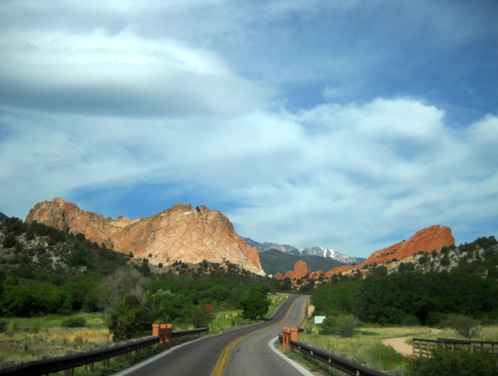
Main park entrance; trail on right connects
to the visitor center and Foothills Trail.
Here's a great description of Garden of the Gods from a colorful
brochure published by the adjacent Trading Post (more about it in the next
entry):
"Filled with the wonders of nature, the Garden of the Gods
was dedicated in 1909 as a free city park. An abundance of plant and animal
life can be found throughout its 1,350 acres, as well as the magnificent red
sandstone rock formations that have made it world-famous. Many of the
formations are over 300 million years old and were sculpted through time by the
forces of nature . . . No trip to Pikes Peak Country is complete without a stop
in the Garden of the Gods, a registered national landmark."
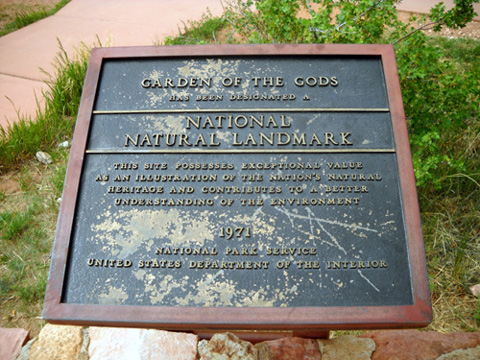
"This site possesses exceptional value as an
illustration of the nation's natural heritage
and contributes to a better understanding of the
environment." (1971, National Park Service)
Like Pike's Peak,
Garden of the Gods is managed by the city of
Colorado Springs. It was bequeathed to the city by railroad magnate Charles
Elliot Perkins with the stipulation that it remain open and free to the public.
The impressive visitor and nature center is also free, although it offers
several options for spending your money!
Donations are also welcomed. The Garden of the Gods Foundation is a
non-profit organization that helps preserve and maintain the park through
grants and donations. I don't know how much of the upkeep comes from local tax
dollars but if I was a resident of Colorado Springs, I wouldn't mind seeing my
local tax dollars being used this way, either (same thing I said about
the Olympic Training Center in a previous entry).
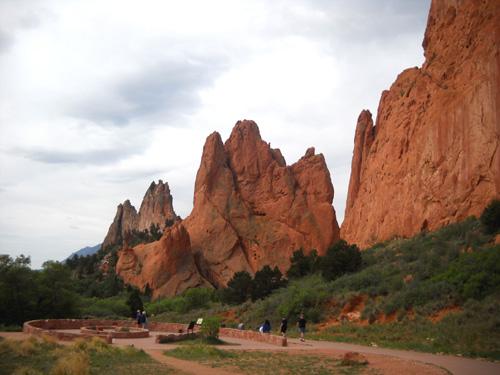
Central Garden Trail near the north main parking
lot
Garden of the Gods
truly is a national natural treasure.
GOTTA GO AGAIN
Jim and I have both been to Garden of the Gods several
times over the last thirty-some years. Another visit during this trip wasn't as
high of a priority for Jim as it was for me. One day we did go
to the visitor center and I took some pictures from the parking
lot and deck overlooking the main entrance:
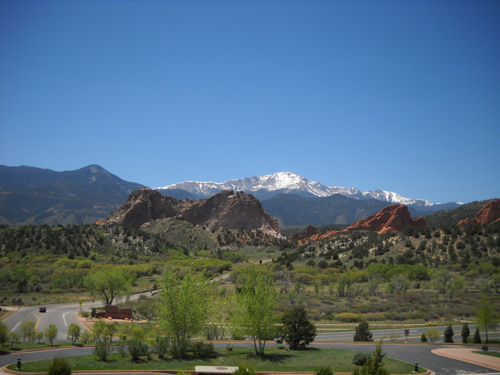
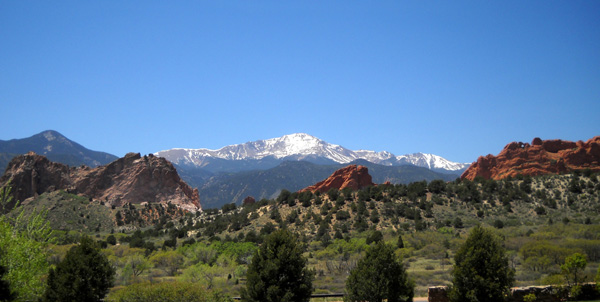
That day we didn't have time to drive or hike through the park,
however.
I wanted more . . . driving by Garden of the Gods isn't
the same as walking amongst the rocks. It'd be like a drive-by
at Bryce Canyon without getting down in those hoodoos:
just not the whole experience.
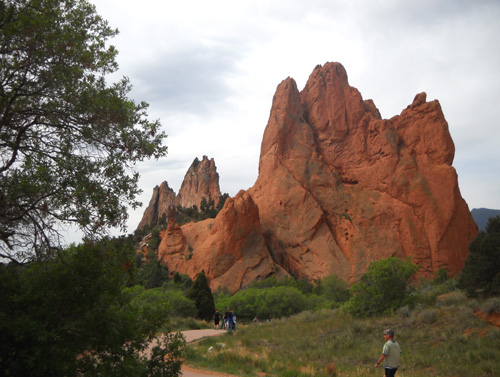
Visitors enjoy some of the rock formations
along the Central Garden Trail at Garden of the Gods
Since this is our last full day in Colorado Springs, Jim wanted
to stay at the campground and do some work on the truck and
camper. Cody and I went out exploring Garden of the Gods and
several other local parks.
WHAT'S IN A NAME?
So how did Garden of the Gods get to be called that?
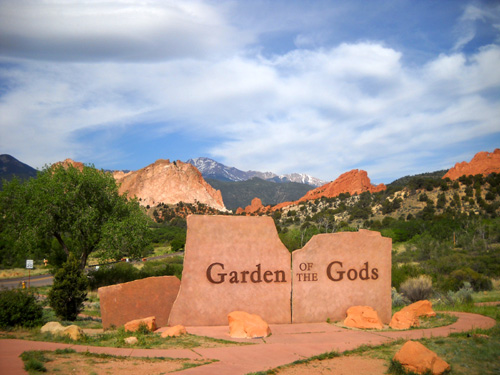
From an interpretive sign along the trail through the main
garden area:
Imagine standing here 150 years ago.
You observe a red rock wilderness, no settlement nearby, and
footpaths traveled by American Indian people for centuries. What
would you name this place?
Back in 1859, not long after the "Pikes
Peak or bust" gold rush began, a group of men explored the
nearby area to determine a place for a town site at the base of
Pikes Peak. They named their new town "Colorado City," as "colorado"
is Spanish for "red," like the surrounding land.
As they looked over this area of
cathedral-like rock spires, one man, Malancthon Beach, commented
that the spot would be a great place for a beer garden someday.
His friend, a poetic young man named Rufous Cable, replied that
it was a place "fit for the Gods."
The name Garden of the Gods has
expressed the awe and admiration felt by Cable and by visitors
ever since.
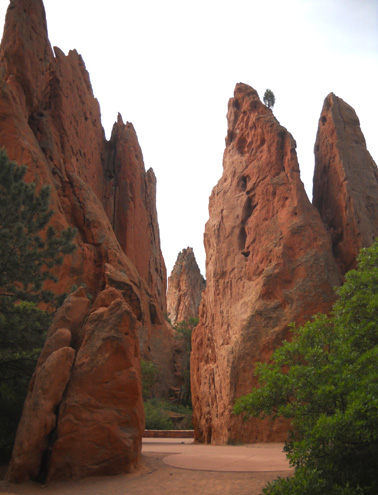
It should be noted that when Charles Perkins bequeathed the land
that is now park property to the city of Colorado Springs, he
and his heirs stipulated that "no intoxicating liquors be
manufactured or sold within the park." I assume that included
beer!
(The other restrictions were that the park "be forever known as
Garden of the Gods, that it shall be forever free and open to
the public, and that no buildings be erected except those
necessary to maintain the park.")
LET'S EXPLORE
I spent about three hours in the morning hiking various trails
and photographing the rock formations before the temperature
climbed into the upper 70s.
I took my time reading lots of
interpretive signs around the park,
hunting for interesting angles for pictures of rocks that
have been photographed a gazillion times by locals and tourists,
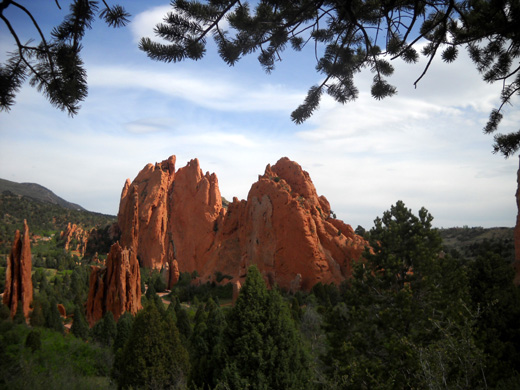
watching rabbits and other small
critters dart through the shrubbery,
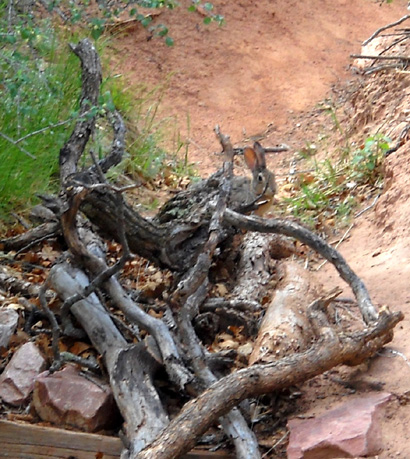
A well-camouflaged rabbit -- can you see
him?
trying to locate birds whose voices I could hear a hundred feet
up in rock crevices,
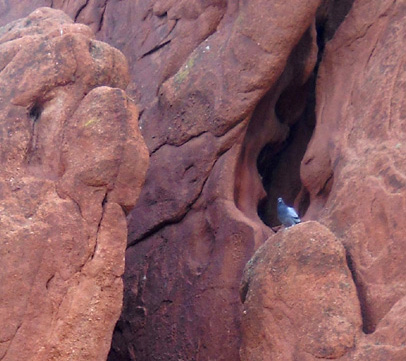
eavesdropping inconspicuously (hard to ignore their chatter!) on comments made by visitors
walking near me, and just generally enjoying the gorgeous day
and perfect weather.
On days like this, I don't even miss not being able to run any
more. If I'd been running, I would have missed a lot.
KISSING CAMELS??
The towering red sandstone formations are the main draw in the
park. You can simply enjoy them without knowing their "names" or
geological history, but I enjoy them even more after learning
how they got there and what they are called.
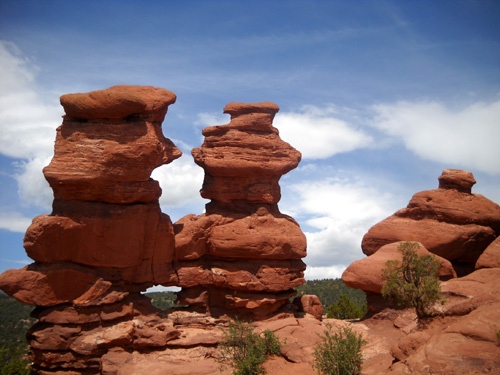
Siamese Twins formation
I mean, aren't the Kissing Camels and Siamese Twins more
interesting if you know that's what they are called??
You can see the Kissing Camels from the visitor center and main
entrance on the east side of the park (see arrow below) . . .
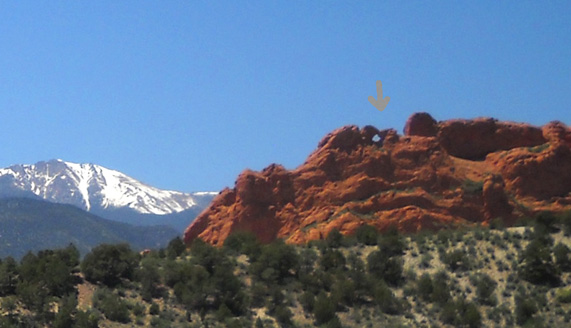
. . . and from various places on the trails on the west side of the
park:
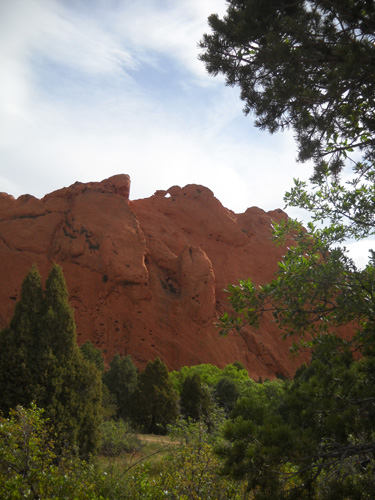
The Kissing Camels look quite different
from the west side of the formation (above and below).
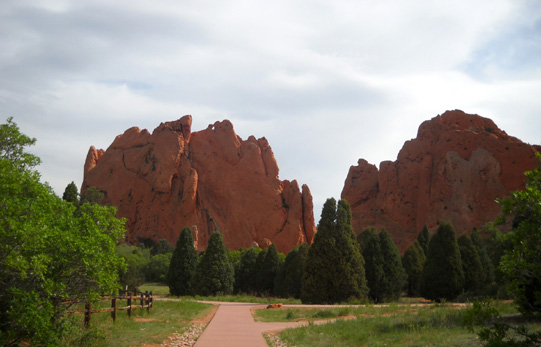
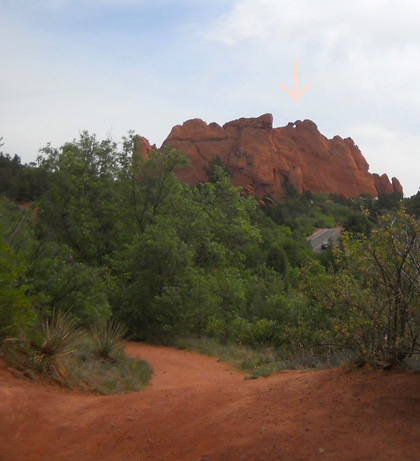
The Camels are visible along the dirt single-track
Palmer Trail heading north.
I think it also enhances the experience to understand how the
rocks were formed over 275-300 million years.
An easy way to learn about the geologic history of the park is
to watch the 14-minute HD Theatre multimedia show in the visitor center to
"see how those red rocks got there." The show costs $5 for
adults and $2 for children.
If you're in a hurry or don't want to spend money on the movie,
you can pick up a free brochure with graphics and text that
explain the geological processes. Or just browse the
interpretive
displays in the visitor/nature center and along the trails. It's
all good.
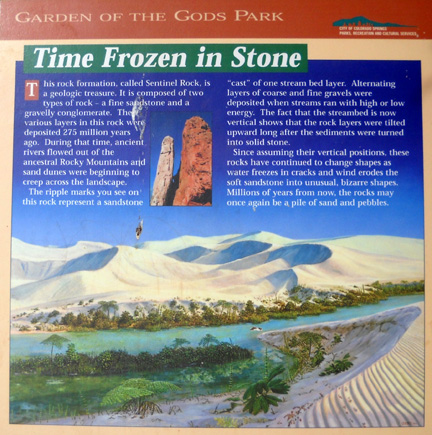
Sign along the trail explaining how the
Sentinel Rock formation began
with fine sandstone and gravelly
conglomerate 275 million years ago
The visitor center, located on the northeast side of the park,
also offers cultural and ecological exhibits, fossils, nature
talks, maps, brochures, a museum, bus and Segway tours, and
information about other things to see and do in the area. There
is a bookstore, gift shop, and indoor/outdoor cafe. Views of the
park and Pike's Peak are pretty cool from the large terrace.
Recreational activities in the park include exploring up to
fifteen miles of
paved and unpaved trails on foot, horseback, or bicycle, guided
nature walks, rock climbing, scenic drives on mostly one-way loops, picnicking,
wildlife viewing, and photography.
EXPLORING THE PARK ON TRAILS
Garden of the Gods has a good network of trails and can even be
accessed on foot or bike from outside the park via the Foothills
Trail along 30th Avenue:
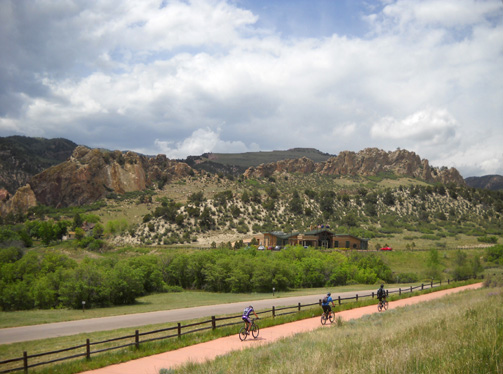
Cyclists on the Foothills bike path just
north of the park
As tough as it can be to find a place to park on a busy day,
walking, running, or riding in on a bike is a great idea!
You can pick up a free colored trail guide in the visitor center
and use that to locate trailheads, distances, and featured rock
formations; I don't think the map is on the park website.
There are also numerous signs throughout the park that show the
trails and the rock formations near where you are standing. Some
of the trails are designed specifically to take visitors to the
more popular rock features, especially the paved Perkins Trail through
the Central Garden Area:
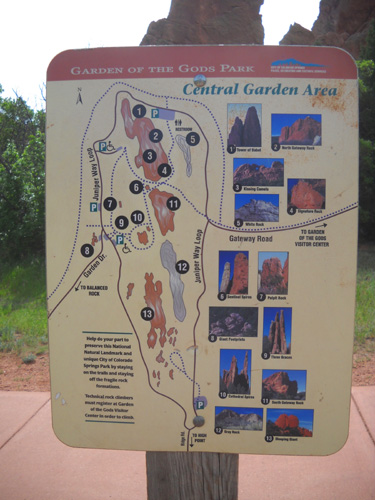
Sign in the popular Central Garden Area
that shows the trails and various rock
formations.
*
All of the trails within the park are open to hikers and
runners.
*
Equestrians are allowed on several designated trails but I
didn't see any horses today.
*
Mountain bikers are limited to a few miles of trail in the
eastern part of the park:
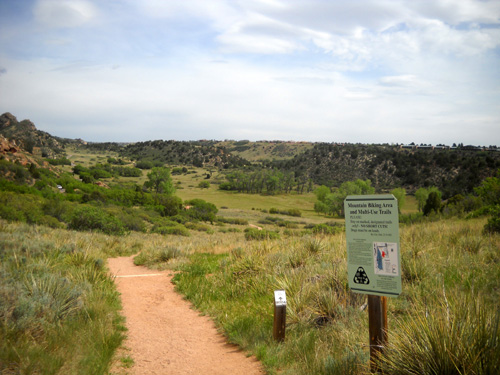
Although the bike trails don't wind through the rock formations,
cyclists can see several of them like Sleeping Giant (left,
below) and Cathedral/Gray Rock (right, below) in the distance:
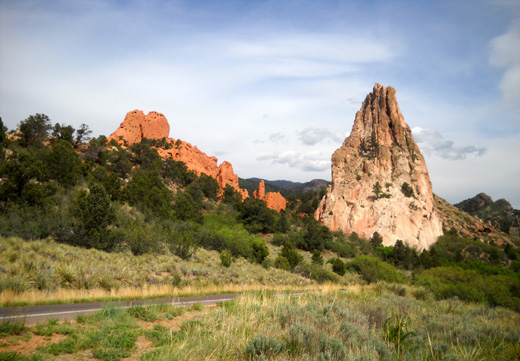
Runners, walkers, and cyclists can also enjoy several miles of
paved bike lanes on the park roads:
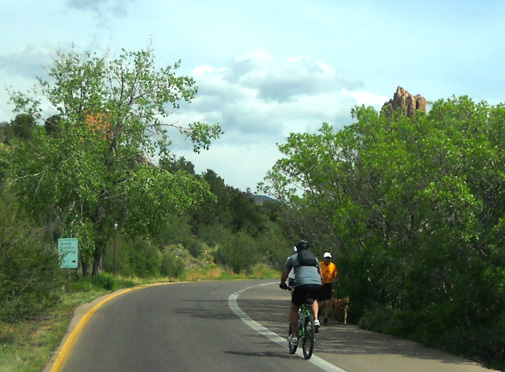
A cyclist moves out of the bike lane to
make room for an oncoming
runner and his dog. Most of the park roads
are one-lane like this.
Some of the trails are rolling dirt single-track:
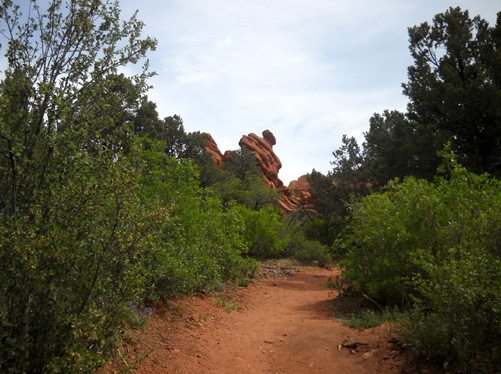
What I've seen of the Palmer Trail is
undulating and mostly smooth.
Some are hillier and rougher than others:
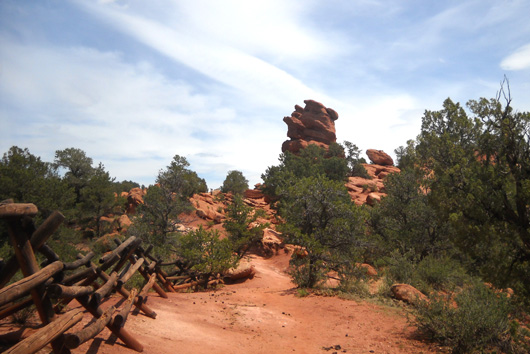
The Siamese Twins Trail (above) and upper
loop are more challenging.
There is a 1½-mile
paved, rather flat loop with two spurs that features the
highest, most popular rock formations. That path is wheel-chair
accessible:
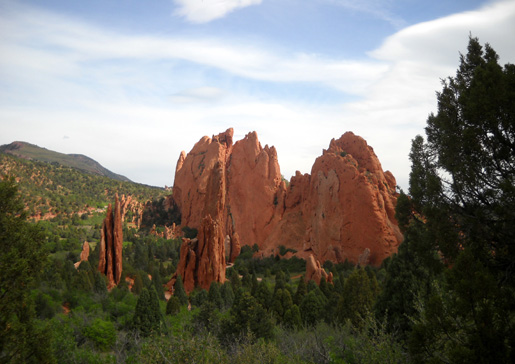
A paved path winds through the Central
Garden Area.
Erosion is a major concern in this kind of terrain. Several park
rules, like staying on trails and not taking home samples of
rocks, are designed to protect the environment and preserve the
natural resources.
Rock climbing without a special permit and proper equipment can
earn folks a big fine. There are signs like this near several of
the more inviting walls to climb:
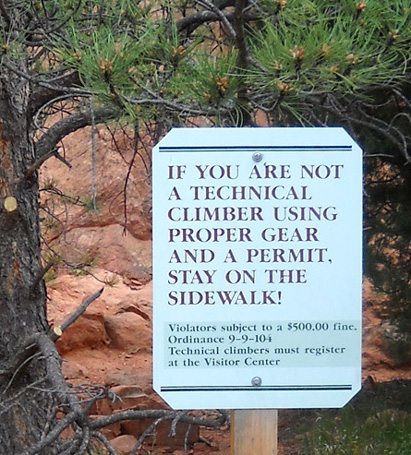
Not only can indiscriminant climbing
destroy the fragile formations, it is also dangerous. Throughout the
park's 100+ year history several serious and fatal rock climbing
accidents have occurred. If you want to rock climb, check out
the park
website re: how to do it
safely and "legally."
THE BEST VIEW IN THE PARK
There are many terrific views of
Pike's Peak from the park. Probably the most unique is this
naturally framed view from the Siamese Twins formation
(you have to get up on the base):
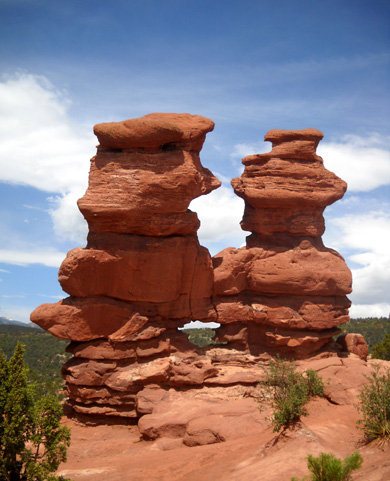
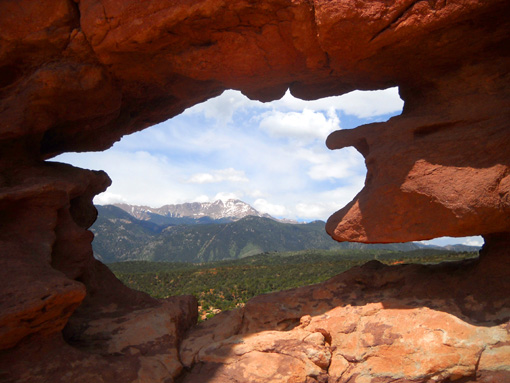
Cool, huh?
There was a young man sitting in
the "window" of the Siamese Twins when Cody and I arrived
on the footpath of the same name. As soon as he saw me whip
out my camera he moved off to the side, behind another rock. I
thanked him for not making me have to "PhotoShop him out of the
picture!"
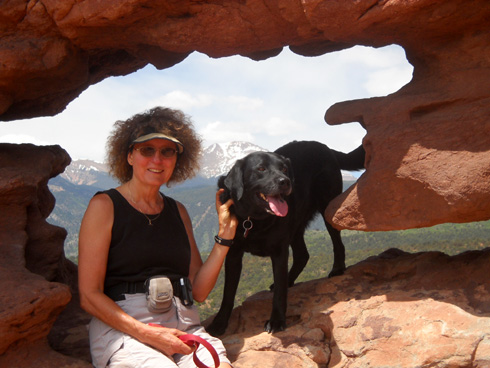
He offered to take my picture with
my camera, and I returned the favor. On a really busy day you
may have trouble getting photos at the Twins without other
people in them. Although it's a hillier, rockier walk to reach
the formation, it's one of the most-photographed spots in the
park.
TOWN & COUNTRY
There are numerous other scenic views of Pike's Peak from most
of the trails within Garden of the Gods. Here are just a few of
them:
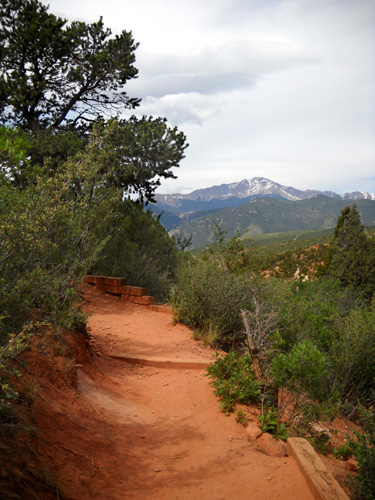
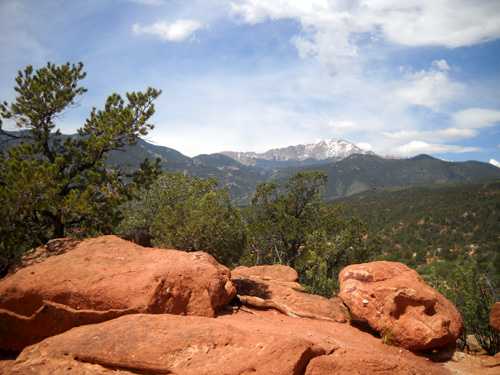
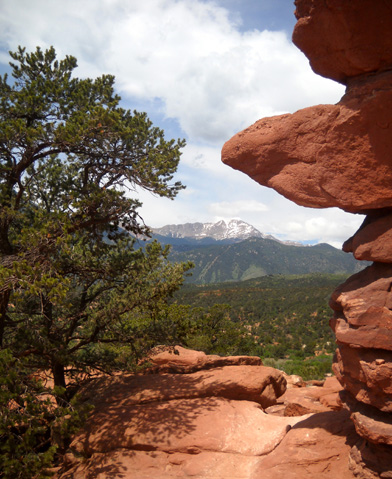
From higher points on the Palmer, Siamese Twins, and Upper Loop
trails you can also see down into Old Colorado City and Manitou
Springs:
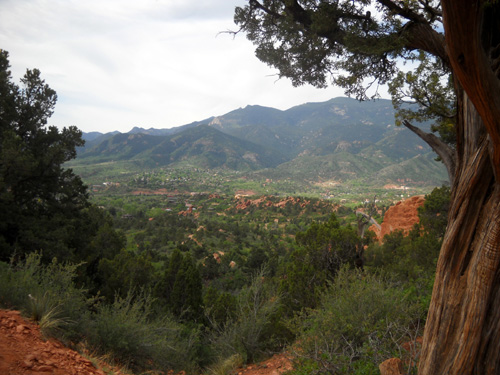
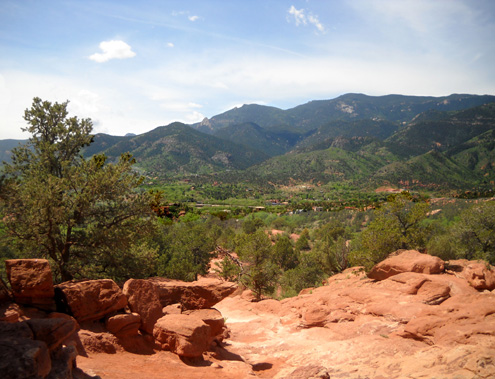
SCENIC DRIVE
After walking around with Cody on three of the trails for a
total of about
five miles it was starting to get pretty warm so we piled into
the car for a scenic tour of the rest of the park that we hadn't
already seen
on foot. (We'd already been partway around to get to the Siamese
Twins and Palmer trails.)
There are four access streets into the park and two one-way
loops within the park. Trying to cover all of them without some
repetition or back-tracking is impossible but they are all short
enough that it's only a problem if the park roads are really
crowded and you're creeping along. If that happens, just keep
your cool and enjoy the views!
This is a small monument we saw near the mountain bike trails;
it marks the trail used by the Plains Indians to reach
nearby Ute Pass:
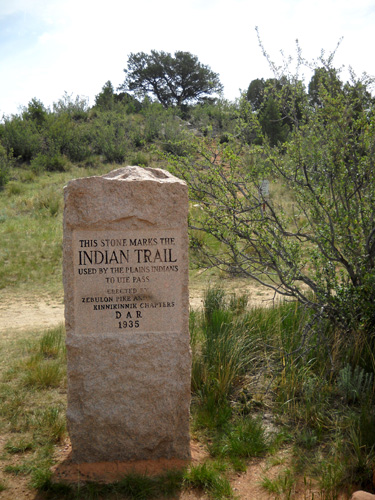
I pulled over several times to check out other trails and rock
formations I'd missed while walking, including the popular
Balanced Rock and Steamboat Rock along Garden Drive in the SW
part of the park.
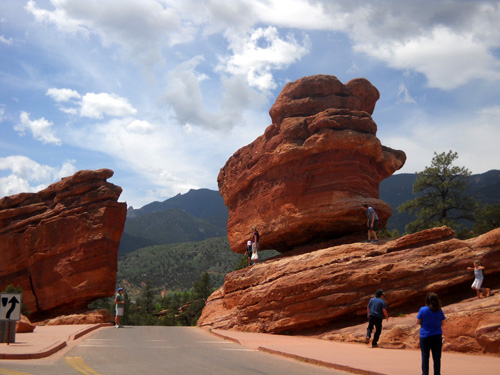
Balanced Rock, right; Steamboat Rock, left
(more of it in another photo farther down)
It's hard to get pictures of those without strangers in them but
at least they give some perspective to the size of the rock
formations.
PLAN YOUR VISIT WISELY
There are trailhead and picnic parking areas
scattered all around the park but most of them are fairly small
and they fill up quickly in the warmer months. Equestrians have
a separate larger parking area near the trading post.
I was able
to get a parking spot quite easily when I arrived at 9 this morning
but by 11 most of the parking areas were getting
full -- even on a weekday. If you visit on a nice
Saturday, Sunday, or holiday, arrive soon after the park opens and
don't expect to move your vehicle to another spot later. You may
end up taking a scenic drive instead of a scenic hike!
Check the park website for operating hours.
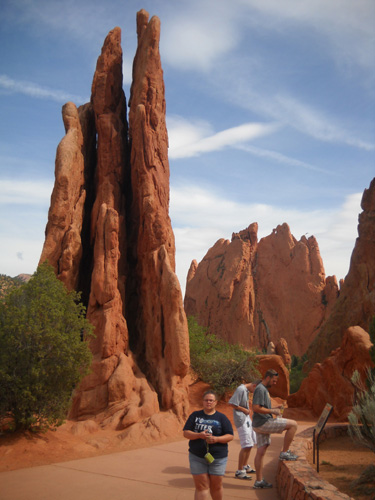
Lots of visitors around, even on a weekday.
Another tip: leave your RV outside the park unless it's a truck
camper or a very small Class B or C. Most of the parking lots
are too small to accommodate campers or motorhomes. Nor can
they even pass through a very narrow rock formation going
northbound at Balanced Rock and Steamboat Rock at the SW end of the park.
I almost had to pull in the side mirrors on the truck to get
through the tight one-way road on one side of Steamboat. It's
to the right in the next photo, although it doesn't show how
tight it is. I was too busy squeezing through without scratching
up the truck to take a picture of the passageway!
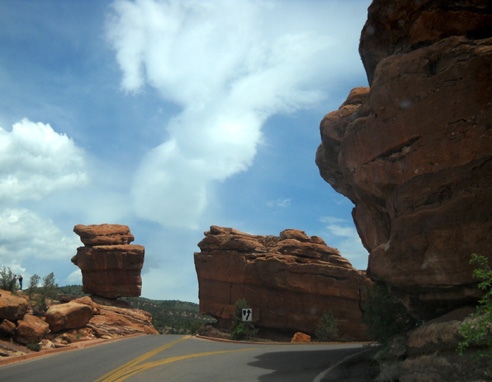
Balanced Rock, left. Steamboat Rock in
center. Narrow passage hidden to the right.
Garden of the Gods is a fun place to visit if you're in the Colorado Springs
area. Check out the scrolling photos at the top of the home page
on the park website,
watch the video, click on the photos link, learn about
recreational activities and tours . . . and maybe you'll
be enticed to visit the park for the first -- or
fifteenth -- time.
Heck, if we lived near there, we'd go quite often. It's a marvelous
resource. I still can't believe it's free!
Next entry: a potpourri of things to do and see in Colorado Springs -- other
parks, other activities in Garden of the Gods, another nice city neighborhood, etc.
Happy trails,
Sue
"Runtrails & Company" - Sue Norwood, Jim O'Neil,
and Cody the Ultra Lab
Previous
Next
© 2010 Sue Norwood and Jim O'Neil